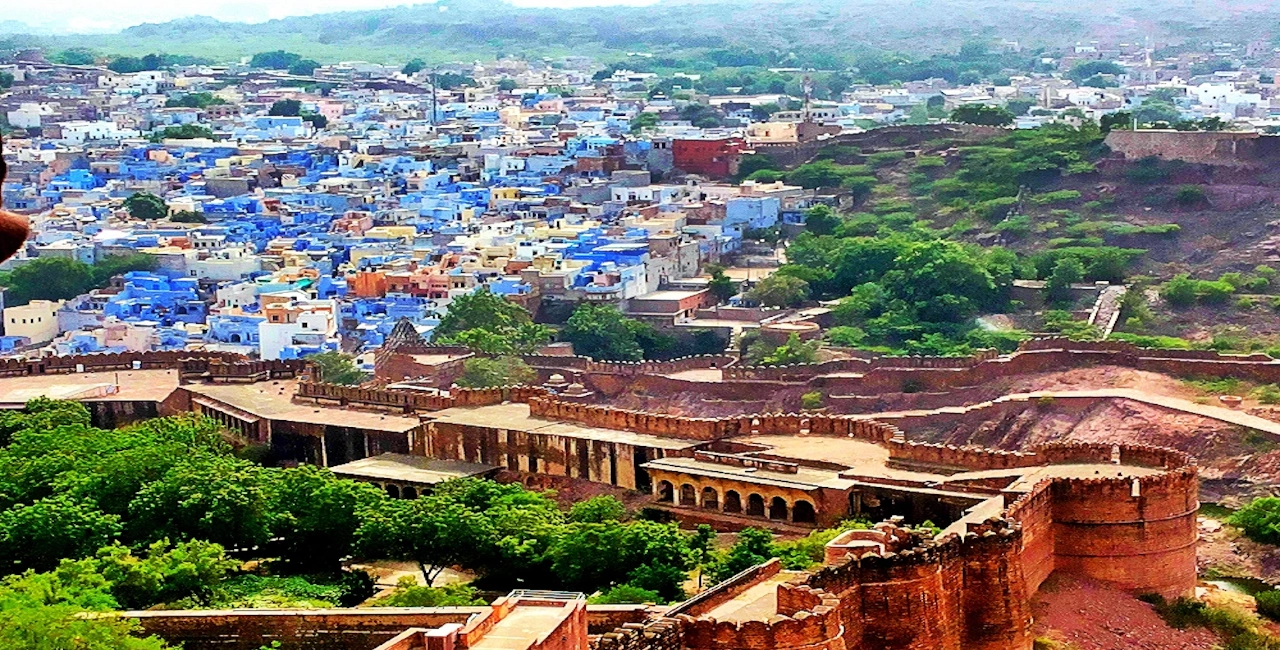Jodhpur, often referred to as the “Blue City” for its striking blue-painted houses, is a vibrant and historic city in the Indian state of Rajasthan. Located on the edge of the Thar Desert, Jodhpur is a blend of royal heritage, colorful culture, and desert charm. With its magnificent forts, palaces, temples, and bustling bazaars, Jodhpur offers visitors a fascinating glimpse into the grandeur of Rajasthan’s regal past.
The Blue City: A Colorful Marvel
One of the most iconic features of Jodhpur is the sea of blue houses that stretch out beneath the towering Mehrangarh Fort. While the exact reason for this distinctive color choice is debated, it is commonly believed that the Brahmins, the highest caste in Hindu society, painted their homes blue to differentiate themselves from other castes. Over time, other residents adopted the practice, and the color became a symbol of the city itself. The blue hue also has practical benefits, as it is thought to help keep homes cool during the scorching desert summers and repel insects.
Walking through the narrow, winding streets of Jodhpur’s old city, one can witness this unique blue architecture firsthand. The vibrant color, contrasted against the golden sandstone buildings and the arid landscape, creates a striking visual appeal that captivates visitors.
Mehrangarh Fort: A Majestic Landmark
Perched 410 feet above the city on a rugged hill, Mehrangarh Fort is one of the largest and most impressive forts in India. Built in 1459 by Rao Jodha, the founder of Jodhpur, this massive structure dominates the city’s skyline. The fort’s imposing walls, towering gates, and intricately designed palaces within reflect the architectural brilliance of Rajasthan’s royal past.
Mehrangarh Fort is not just a military stronghold; it is also a cultural treasure trove. Inside the fort, visitors can explore a series of beautifully crafted palaces, including Moti Mahal (Pearl Palace), Phool Mahal (Flower Palace), and Sheesh Mahal (Mirror Palace), each showcasing the opulent lifestyle of the Marwar rulers. The fort houses an impressive museum, which exhibits a collection of royal artifacts, costumes, weapons, and paintings that provide insight into the region’s history and culture.
The Chokelao Garden inside the fort offers a serene escape with its lush greenery and fountains, providing a peaceful spot to relax after exploring the fort’s grandeur. From the fort’s ramparts, visitors can enjoy panoramic views of the Blue City below, a breathtaking sight that captures the essence of Jodhpur’s beauty.
Umaid Bhawan Palace: A Royal Residence
Another architectural marvel in Jodhpur is the Umaid Bhawan Palace, one of the largest private residences in the world. This magnificent palace was built between 1928 and 1943 by Maharaja Umaid Singh as a way to provide employment to the people of Jodhpur during a severe drought. Designed by British architect Henry Lanchester, the palace is a blend of Indo-Saracenic and Art Deco styles, making it a unique structure that stands apart from traditional Rajasthani architecture.
Today, Umaid Bhawan Palace is divided into three parts: a luxury hotel, a museum, and the private residence of the royal family. The museum showcases artifacts from the royal family’s history, including vintage cars, clocks, and photographs, offering visitors a glimpse into the opulent lifestyle of the Jodhpur royals. For those seeking an indulgent experience, the hotel provides a chance to stay in this royal palace, complete with lavish interiors and world-class amenities.
The Bustling Bazaars of Jodhpur
Jodhpur’s markets are a sensory delight, offering a vibrant array of colors, sounds, and aromas. The city’s most famous market is the Sardar Market, located near the landmark Ghanta Ghar (Clock Tower). This bustling bazaar is the heart of the city’s commercial life, where locals and tourists alike can shop for a variety of traditional Rajasthani goods, including textiles, handicrafts, spices, and jewelry.
Jodhpur is renowned for its fine bandhani (tie-dye) textiles, leheriya (wave-patterned fabric), and intricate mojris (traditional leather footwear). Visitors can also find antique furniture, silver jewelry, and vibrant pottery, making the bazaars an ideal place to pick up souvenirs that reflect the craftsmanship and culture of Rajasthan.
For food enthusiasts, Jodhpur’s street food is a culinary adventure. The city is famous for its mirchi vada (spicy chili fritters), pyaaz kachori (onion-filled pastry), and sweet treats like mawa kachori and makhania lassi. Sampling these local delicacies is a must for any visitor seeking an authentic taste of Jodhpur’s flavors.
The Thar Desert: A Gateway to Adventure
Jodhpur serves as the gateway to the Thar Desert, offering a range of desert experiences for adventurous travelers. The nearby Osian village, located about 65 kilometers from Jodhpur, is a popular destination for camel safaris and desert camping. Known as the “Khajuraho of Rajasthan” for its intricately carved temples, Osian is a historical town with both Hindu and Jain temples dating back to the 8th and 11th centuries.
A camel safari through the sand dunes of Osian provides a unique way to explore the stark beauty of the desert landscape, while a night spent in a desert camp allows visitors to experience the tranquility of the Thar under a star-filled sky. For those seeking more adventure, jeep safaris and dune bashing are also popular activities in the region.
Conclusion
Jodhpur, with its blend of history, architecture, culture, and desert adventure, offers an unforgettable experience to visitors. Whether you’re exploring the majestic Mehrangarh Fort, wandering through the vibrant streets of the Blue City, or embarking on a camel safari into the Thar Desert, Jodhpur captures the essence of Rajasthan’s royal past and desert charm. Its unique mix of cultural heritage, colorful markets, and stunning landscapes makes it a must-visit destination for anyone traveling to India.


0 Comment